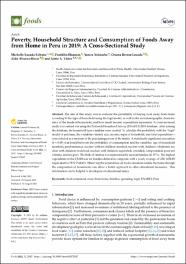Poverty, Household Structure and Consumption of Foods Away from Home in Peru in 2019: A Cross-Sectional Study

View/
Download
(application/pdf: 862.7Kb)
(application/pdf: 862.7Kb)
Date
2022-08-23Author(s)
Lozada-Urbano, Michelle
Huamán, Franklin
Xirinachs, Yanira
Rivera-Lozada, Oriana
Alvarez-Risco, Aldo
Yáñez, Jaime A.
Metadata
Show full item recordAbstract
The aim of this study was to evaluate the probability of buying food away from home according to the type of household using the logit model, as well as the sociodemographic characteristics of the heads of household, and how much income expenditure represents. A cross-sectional study was carried out using the National Household Survey (ENAHO) 2019 database. After joining the database, the household type variables were created. To calculate the probability with the “logit” model of purchase, the variables—family size, income, types of household, and total expenditure—were selected as a measure of the purchasing power of the family. A statistically significant association (p < 0.05) was found between the probability of consumption and the variables: age of household members, predominance, nuclear without children–married, nuclear with children–cohabitant, nuclear with children–widowed, nuclear with children–separated, extended, compounded, poor not extreme, and not poor. The bulk of families was represented by nuclear families (61.97%). The highest expenditure in the CFAH was for families defined as composite with a yearly average of USD 1652.89 (equivalent to PEN 5520.67). Observing the expenditure on food consumed outside the home through the composition of households can allow a better approach to offer educational measures. This information can be helpful to developers of educational issues. View Full-Text
Collections
- Web of Science (WOS) [236]

